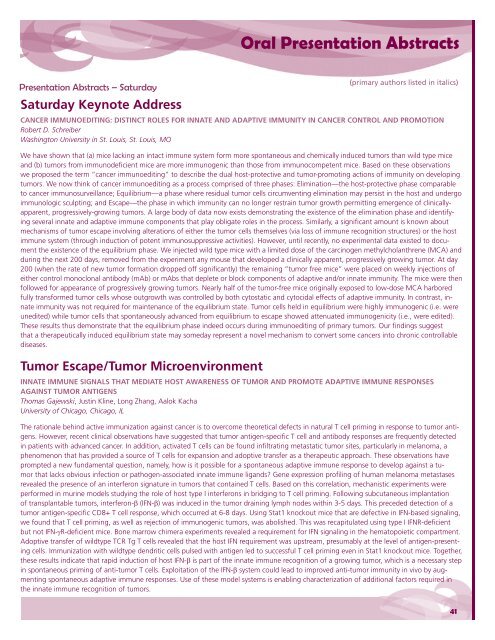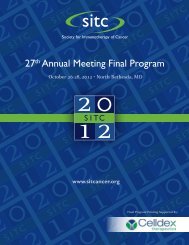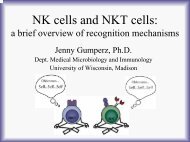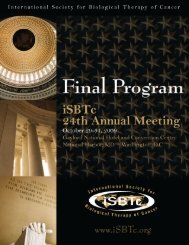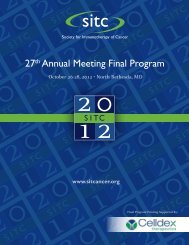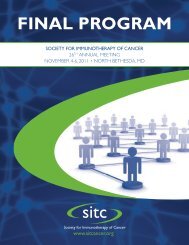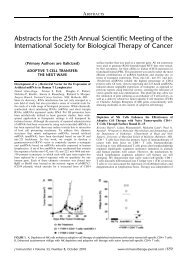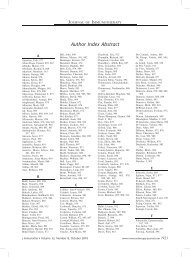Download Final Program - Society for Immunotherapy of Cancer
Download Final Program - Society for Immunotherapy of Cancer
Download Final Program - Society for Immunotherapy of Cancer
Create successful ePaper yourself
Turn your PDF publications into a flip-book with our unique Google optimized e-Paper software.
Oral Presentation AbstractsPresentation Abstracts – SaturdaySaturday Keynote Address(primary authors listed in italics)CANCER IMMUNOEDITING: DISTINCT ROLES FOR INNATE AND ADAPTIVE IMMUNITY IN CANCER CONTROL AND PROMOTIONRobert D. SchreiberWashington University in St. Louis, St. Louis, MOWe have shown that (a) mice lacking an intact immune system <strong>for</strong>m more spontaneous and chemically induced tumors than wild type miceand (b) tumors from immunodeficient mice are more immunogenic than those from immunocompetent mice. Based on these observationswe proposed the term “cancer immunoediting” to describe the dual host-protective and tumor-promoting actions <strong>of</strong> immunity on developingtumors. We now think <strong>of</strong> cancer immunoediting as a process comprised <strong>of</strong> three phases: Elimination—the host-protective phase comparableto cancer immunosurveillance; Equilibrium—a phase where residual tumor cells circumventing elimination may persist in the host and undergoimmunologic sculpting; and Escape—the phase in which immunity can no longer restrain tumor growth permitting emergence <strong>of</strong> clinicallyapparent,progressively-growing tumors. A large body <strong>of</strong> data now exists demonstrating the existence <strong>of</strong> the elimination phase and identifyingseveral innate and adaptive immune components that play obligate roles in the process. Similarly, a significant amount is known aboutmechanisms <strong>of</strong> tumor escape involving alterations <strong>of</strong> either the tumor cells themselves (via loss <strong>of</strong> immune recognition structures) or the hostimmune system (through induction <strong>of</strong> potent immunosuppressive activities). However, until recently, no experimental data existed to documentthe existence <strong>of</strong> the equilibrium phase. We injected wild type mice with a limited dose <strong>of</strong> the carcinogen methylcholanthrene (MCA) andduring the next 200 days, removed from the experiment any mouse that developed a clinically apparent, progressively growing tumor. At day200 (when the rate <strong>of</strong> new tumor <strong>for</strong>mation dropped <strong>of</strong>f significantly) the remaining “tumor free mice” were placed on weekly injections <strong>of</strong>either control monoclonal antibody (mAb) or mAbs that deplete or block components <strong>of</strong> adaptive and/or innate immunity. The mice were thenfollowed <strong>for</strong> appearance <strong>of</strong> progressively growing tumors. Nearly half <strong>of</strong> the tumor-free mice originally exposed to low-dose MCA harboredfully trans<strong>for</strong>med tumor cells whose outgrowth was controlled by both cytostatic and cytocidal effects <strong>of</strong> adaptive immunity. In contrast, innateimmunity was not required <strong>for</strong> maintenance <strong>of</strong> the equilibrium state. Tumor cells held in equilibrium were highly immunogenic (i.e. wereunedited) while tumor cells that spontaneously advanced from equilibrium to escape showed attenuated immunogenicity (i.e., were edited).These results thus demonstrate that the equilibrium phase indeed occurs during immunoediting <strong>of</strong> primary tumors. Our findings suggestthat a therapeutically induced equilibrium state may someday represent a novel mechanism to convert some cancers into chronic controllablediseases.Tumor Escape/Tumor MicroenvironmentINNATE IMMUNE SIGNALS THAT MEDIATE HOST AWARENESS OF TUMOR AND PROMOTE ADAPTIVE IMMUNE RESPONSESAGAINST TUMOR ANTIGENSThomas Gajewski, Justin Kline, Long Zhang, Aalok KachaUniversity <strong>of</strong> Chicago, Chicago, ILThe rationale behind active immunization against cancer is to overcome theoretical defects in natural T cell priming in response to tumor antigens.However, recent clinical observations have suggested that tumor antigen-specific T cell and antibody responses are frequently detectedin patients with advanced cancer. In addition, activated T cells can be found infiltrating metastatic tumor sites, particularly in melanoma, aphenomenon that has provided a source <strong>of</strong> T cells <strong>for</strong> expansion and adoptive transfer as a therapeutic approach. These observations haveprompted a new fundamental question, namely, how is it possible <strong>for</strong> a spontaneous adaptive immune response to develop against a tumorthat lacks obvious infection or pathogen-associated innate immune ligands? Gene expression pr<strong>of</strong>iling <strong>of</strong> human melanoma metastasesrevealed the presence <strong>of</strong> an interferon signature in tumors that contained T cells. Based on this correlation, mechanistic experiments wereper<strong>for</strong>med in murine models studying the role <strong>of</strong> host type I interferons in bridging to T cell priming. Following subcutaneous implantation<strong>of</strong> transplantable tumors, interferon-β (IFN-β) was induced in the tumor draining lymph nodes within 3-5 days. This preceded detection <strong>of</strong> atumor antigen-specific CD8+ T cell response, which occurred at 6-8 days. Using Stat1 knockout mice that are defective in IFN-based signaling,we found that T cell priming, as well as rejection <strong>of</strong> immunogenic tumors, was abolished. This was recapitulated using type I IFNR-deficientbut not IFN-γR-deficient mice. Bone marrow chimera experiments revealed a requirement <strong>for</strong> IFN signaling in the hematopoietic compartment.Adoptive transfer <strong>of</strong> wildtype TCR Tg T cells revealed that the host IFN requirement was upstream, presumably at the level <strong>of</strong> antigen-presentingcells. Immunization with wildtype dendritic cells pulsed with antigen led to successful T cell priming even in Stat1 knockout mice. Together,these results indicate that rapid induction <strong>of</strong> host IFN-β is part <strong>of</strong> the innate immune recognition <strong>of</strong> a growing tumor, which is a necessary stepin spontaneous priming <strong>of</strong> anti-tumor T cells. Exploitation <strong>of</strong> the IFN-β system could lead to improved anti-tumor immunity in vivo by augmentingspontaneous adaptive immune responses. Use <strong>of</strong> these model systems is enabling characterization <strong>of</strong> additional factors required inthe innate immune recognition <strong>of</strong> tumors.41


